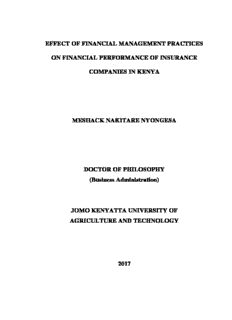Table Of ContentEFFECT OF FINANCIAL MANAGEMENT PRACTICES
ON FINANCIAL PERFORMANCE OF INSURANCE
COMPANIES IN KENYA
MESHACK NAKITARE NYONGESA
DOCTOR OF PHILOSOPHY
(Business Administration)
JOMO KENYATTA UNIVERSITY OF
AGRICULTURE AND TECHNOLOGY
2017
Effect of Financial Management Practices on Financial Performance
of Insurance Companies in Kenya
Meshack Nakitare Nyongesa
A Thesis Submitted in Partial Fulfillment for the Degree of Doctor
of Philosophy in Business Administration in the Jomo Kenyatta
University of Agriculture and Technology
2017
DECLARATION
This thesis is my original work and has not been presented for a degree in any other
university.
Signature: …………………….…………………… Date: …………………………
Meshack Nakitare Nyongesa
This thesis has been submitted for examination with our approval as university
supervisors:
Signature: …………………….…………………… Date: …………………………
Dr. Mouni Gekara, PhD
The East African University, Kenya
Signature: …………………….…………………… Date: …………………………
Dr. Kennedy Ogollah, PhD
UoN, Kenya
Signature: …………………….…………………… Date: …………………………
Prof. Gichuhi A. Waititu, PhD
JKUAT, Kenya
ii
DEDICATION
I dedicate this thesis to my family and friends for their encouragement, advice and
support that they accorded me during my studies.
iii
ACKNOWLEDGEMENT
I wish to acknowledge my supervisors Dr. Mouni Gekara, Dr. Kennedy Ogollah and
Prof. Anthony Waititu for the encouragement, guidance, constant follow-ups and
suggestions for the improvement of this thesis. Special thanks goes to all my
lecturers, friends and those who contributed in one way or another in my entire
learning period.
I cannot forget my spouse Catherine Nakitare, my children, my parents, brothers,
sisters, uncles, aunties, my in-laws and my colleagues at the College of Insurance for
their unwavering prayers, support and encouragement. Lastly special thanks to the
Almighty God for with Him, everything was made possible.
iv
TABLE OF CONTENTS
DECLARATION ........................................................................................................ ii
DEDICATION ...........................................................................................................iii
ACKNOWLEDGEMENT ........................................................................................ iv
TABLE OF CONTENTS ........................................................................................... v
LIST OF TABLES .................................................................................................... ix
LIST OF FIGURES ................................................................................................. xv
LIST OF APPENDICES ....................................................................................... xvii
OPERATIONAL DEFINITION OF TERMS ....................................................xviii
ABBREVIATIONS AND ACRONYMS ................................................................ xx
ABSTRACT ............................................................................................................ xxii
CHAPTER ONE ........................................................................................................ 1
INTRODUCTION ...................................................................................................... 1
1.1 Background of the Study .................................................................................... 1
1.2 Statement of the Problem ................................................................................. 14
1.3 Objectives of the Study .................................................................................... 17
1.4 Research Hypotheses ....................................................................................... 18
1.5 Significance of the Study ................................................................................. 18
1.6 Scope of the Study ........................................................................................... 19
1.7 Limitations of the study ................................................................................... 20
v
1.8 Delimitation of the Study ................................................................................. 20
CHAPTER TWO ..................................................................................................... 21
LITERATURE REVIEW ........................................................................................ 21
2.1 Introduction ...................................................................................................... 21
2.2 Theoretical Review .......................................................................................... 21
2.3 Conceptual Framework .................................................................................... 30
2.4 Empirical Review ............................................................................................. 39
2.5 Critique of Existing Literature ......................................................................... 57
2.6 Research Gaps .................................................................................................. 60
2.7 Chapter Summary............................................................................................. 63
CHAPTER THREE ................................................................................................. 65
RESEARCH METHODOLOGY ........................................................................... 65
3.1 Introduction ...................................................................................................... 65
3.2 Research Design ............................................................................................... 65
3.3 Research Philosophy ........................................................................................ 66
3.4 Population of the Study .................................................................................... 67
3.5 Sampling Frame ............................................................................................... 68
3.6 Sampling Design .............................................................................................. 69
3.7 Sample Size ...................................................................................................... 69
3.8 Data Collection Instrument .............................................................................. 71
vi
3.9 Pilot Test .......................................................................................................... 72
3.10 Data Processing and Analysis ........................................................................ 74
3.11 Diagnostic Tests ............................................................................................. 79
CHAPTER FOUR .................................................................................................... 82
RESEARCH FINDINGS AND DISCUSSION ...................................................... 82
4.1 Introduction ...................................................................................................... 82
4.2 Response Rate .................................................................................................. 82
4.3 Pilot Test Results ............................................................................................. 83
4.4 Demographic Information ................................................................................ 85
4.5 Financial Performance ..................................................................................... 89
4.6 Working Capital Management ....................................................................... 100
4.7 Capital Budgeting Techniques ....................................................................... 113
4.8 Capital structure Decisions ............................................................................ 128
4.9 Claims Management Policies ......................................................................... 141
4.10 Corporate Governance ................................................................................. 156
4.11 Firm Characteristics ..................................................................................... 169
4.12 Overall Correlation Analysis........................................................................ 180
4. 13 Joint Regression before Moderation ........................................................... 182
4.14 Regression Analysis after Moderation ......................................................... 185
4.15 Revised Conceptual Framework .................................................................. 192
vii
CHAPTER FIVE .................................................................................................... 194
SUMMARY, CONCLUSIONS AND RECOMMENDATIONS ....................... 194
5.1 Introduction .................................................................................................... 194
5.2 Summary of the Findings ............................................................................... 194
5.3 Conclusion ..................................................................................................... 205
5.4 Recommendations of the study ...................................................................... 206
5.5 Areas for Further Research ............................................................................ 208
REFERENCES ....................................................................................................... 209
APPENDICES ........................................................................................................ 237
viii
LIST OF TABLES
Table 4.1: Response Rate .......................................................................................... 82
Table 4.2: Reliability Results .................................................................................... 84
Table 4.3: Level of Education ................................................................................... 87
Table 4.4: Reliability Test for Financial Performance .............................................. 89
Table 4.5: KMO Sampling Adequacy and Bartlett's Sphericity Tests ...................... 90
Table 4.6: Financial Performance Total Variance Explained ................................... 91
Table 4.7: Financial Performance Factor Analysis Component Matrix ................... 91
Table 4.8: Financial Performance Descriptive .......................................................... 92
Table 4.9: Results of Kolmogorov-Smirnov Test for Normality .............................. 97
Table 4.10: Multi-collinearity Test Results............................................................... 98
Table 4.11: Results of Breusch-Pagan / Cook-Weisberg Test for Heteroscedasticity
............................................................................................................................ 99
Table 4.12: Durbin-Watson Results ........................................................................ 100
Table 4.13: Reliability Test for Working Capital Management.............................. 101
Table 4.14: KMO Sampling Adequacy and Bartlett's Sphericity Tests .................. 102
Table 4.15: Working Capital Management Total Variance Explained ................... 102
Table 4.16: Working Capital Management Factor Analysis Component Matrix ... 103
Table 4.17: Working Capital Management Descriptive.......................................... 104
Table 4.18: Model Summary ................................................................................... 106
Table 4.19: Analysis of Variance (ANOVA) .......................................................... 107
Table 4.20: Regression Analysis for Working Capital Management and Financial
Performance ..................................................................................................... 107
Table 4.21: Model Summary ................................................................................... 108
ix
Description:I wish to acknowledge my supervisors Dr. Mouni Gekara, Dr. Kennedy Ogollah and. Prof. result in a financial loss (Arif, & Showket, 2015). country specific studies on what influences profitability and performance. included Crime and anti-money laundering Guideline, Group life (Listed Risks).

